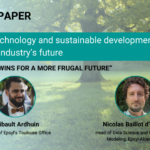PART 3 – SYSTEMS ENGINEERING: THE CORNERSTONE OF A SYSTEMS APPROACH TO SUSTAINABILITY
Frugality and restraint in practices, energy consumption and raw materials is one of the main objectives of the industry. Digital continuity with systems engineering enables to rethink processes and organizational structures and enter a more virtuous cycle. Our experts shed light on new areas of exploration. With Pierre Sans, Systems engineering expert, KEONYS and Thomas Blume, Head of 3DS-PLM Competency Center, Cenit
Enter model-based systems engineering
Model-based systems engineering, or MBSE, lets us consolidate and identify requirements and reconcile all constraints and expectations in a more functional and universal framework. “With MBSE, we can now deliver on this promise through a more dynamic and structured approach, taking systems engineering to new heights of clarity and performance,” explains Thomas Blume.
The key element in the complex and demanding discipline of systems engineering is requirements engineering. “Factoring in sustainability translates into new requirements, which must be identified, set out, then prioritized,” says Pierre Sans.
Systems engineering and sustainability: a systemic vision of an industrial project
Considering the sustainability of a product means considering each stage in the product life cycle. “Product ecodesign only makes sense if you take a holistic approach,” says Pierre Sans. Why develop a virtuous product if the way it’s shipped to the point of delivery creates pollution? And how can we claim to be eco-friendly if we don’t consider a product’s second life or end of life? “Systems engineering combined with digital continuity lets us address all these issues”, concludes Pierre Sans.





